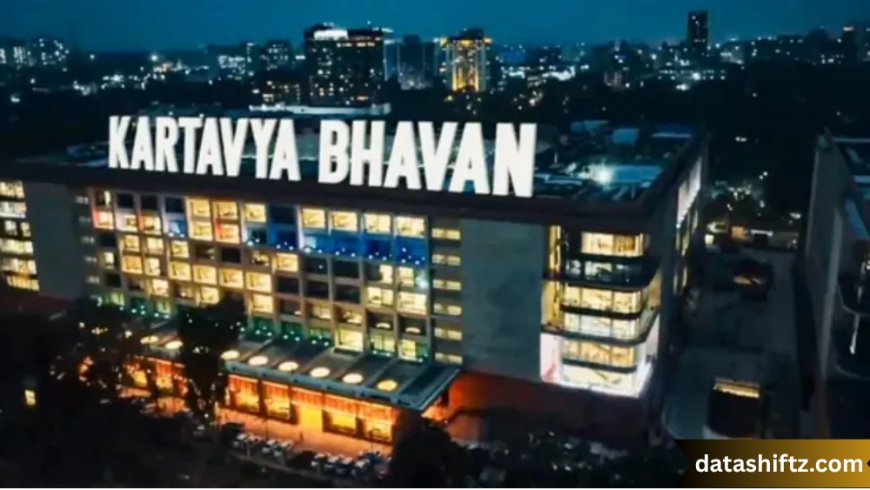Kartavya Bhavan: The New Pillar of India's Democratic Governance

Introduction
In the evolving narrative of India's governance and institutional infrastructure, Kartavya Bhavan has emerged as a symbol of duty, service, and national commitment. Translating to "Duty Building," Kartavya Bhavan represents a major leap in administrative modernization while reflecting India’s ethos of seva (service) and kartavya (duty).
Located in the heart of New Delhi, Kartavya Bhavan is not merely a building — it is a vision of efficient governance. Developed under the ambitious Central Vista Redevelopment Project, this building is slated to serve as a key office space for government ministries and departments, reinforcing India's ambition to create world-class infrastructure for its administrative framework.
This blog explores the origin, purpose, design, key features, and implications of Kartavya Bhavan for India’s future.
What is Kartavya Bhavan?
A Modern Administrative Hub
Kartavya Bhavan is a newly constructed government office complex being developed as part of the Central Vista Project — the ambitious plan to revamp New Delhi’s administrative district. Spearheaded by the Government of India, the building is being created to house multiple ministries, thus centralizing operations and improving interdepartmental coordination.
Previously referred to by names like Common Central Secretariat or “New Government Office Complex,” the building was renamed Kartavya Bhavan in 2023 to reflect the government's focus on "duty before power", aligning with Prime Minister Narendra Modi’s emphasis on citizens’ duties in a democracy.
Historical Context and Purpose
Why India Needed Kartavya Bhavan
India’s central government functions were previously scattered across over 45 rented office buildings in Delhi, many of which were decades old and inefficient in terms of space, energy, and security. This fragmentation led to delays, lack of communication, and excessive administrative overheads.
Objectives Behind the Creation of Kartavya Bhavan:
-
Administrative Integration – Bring multiple ministries under one roof.
-
Improved Infrastructure – Replace outdated offices with modern facilities.
-
Security and Sustainability – Build a future-ready, green-certified structure.
-
Cultural and National Identity – Reflect Indian architecture and values.
-
Reduce Government Expenditure – Eliminate massive annual rental bills.
Key Features and Architecture of Kartavya Bhavan
A Fusion of Heritage and Modernity
Designed by renowned architect Bimal Patel, Kartavya Bhavan reflects a careful blend of classical Indian architecture and modern design sensibilities. It is envisioned not just as an office block but as a monument of national duty — incorporating sustainability, technology, and accessibility.
???? Architectural Features (List Form)
-
Earthquake-resistant structure
-
LEED and GRIHA certified green building
-
Modern security surveillance systems
-
Rainwater harvesting and solar energy
???? Kartavya Bhavan – At a Glance (Table Form)
| Feature | Details |
|---|---|
| Location | Central Vista, New Delhi |
| Architect | Bimal Patel (HCP Design) |
| Purpose | Centralized Government Offices |
| Ministries Housed | 10–15 (projected) |
| Built-up Area | Over 9 lakh sq. ft. |
| Number of Floors | G+5 or more (subject to final design) |
| Energy Source | Solar + Grid |
| Eco-certifications | LEED, GRIHA |
| Accessibility | 100% Barrier-Free |
| Connectivity | Metro, Road, and Pedestrian-Friendly |
Significance in the Central Vista Project
The Bigger Picture
The Central Vista Redevelopment Project is one of the most high-profile infrastructure projects in modern Indian history. Kartavya Bhavan is a crucial component of this project, which includes:
-
New Parliament House
-
New Prime Minister’s Office and Residence
-
Vice President’s Enclave
-
Upgraded Rajpath (Kartavya Path)
-
Reconstructed India Gate lawns and museums
Kartavya Bhavan complements the architectural grandeur of the New Parliament House, showcasing India's determination to redefine its symbols of power with symbols of responsibility and service.
Impact on Governance and Public Services
Improving Bureaucratic Efficiency
With over 50% of central government offices operating out of leased properties before Kartavya Bhavan, bureaucratic operations were often delayed due to logistical hurdles. The new building addresses this gap by:
✅ Expected Benefits (List Form)
-
Faster Inter-Ministerial Coordination
-
Time and Cost Savings
-
Enhanced Public Access to Ministries
-
Better Data Security and IT Management
-
Professional Work Environment for Staff
Public Reception and Political Perspectives
Appreciations and Criticisms
The inauguration and renaming of Kartavya Bhavan drew mixed reactions from the public, political leaders, and urban planners. While many hailed it as a symbol of India’s administrative renaissance, others viewed it through a lens of political branding and capital expenditure concerns.
???? Public and Political Viewpoints (Table Form)
| Stakeholder | Response |
|---|---|
| Government | Called it a move toward efficient governance |
| Opposition Parties | Criticized costs and timing during national issues |
| Urban Planners | Appreciated the eco-friendly, centralized concept |
| Public Sentiment | Divided; some saw pride, others questioned priority |
| Media Analysts | Mixed reviews, but acknowledged infrastructure boost |
Future Outlook and Integration
What Lies Ahead for Kartavya Bhavan
Kartavya Bhavan is just the beginning of what could become a new era in Indian bureaucratic and civic architecture. Future expansions, smarter integrations with AI-based governance tools, and public-friendly amenities may further enhance its value.
???? Future Prospects (List Form)
-
Integration with AI-enabled dashboards for ministers and bureaucrats
-
Remote work compatibility with hybrid government workspaces
-
Hosting public outreach programs and citizen forums
-
Digital display zones showcasing ministry initiatives
-
Civic education corners for visitors and students
-
Public grievance redressal kiosks integrated into the lobby
-
Use of blockchain for document security
-
Dedicated co-working zones for inter-ministerial collaborations
-
Increased use of VR/AR for public presentations
-
Expansion to state-level Kartavya Bhavans
Conclusion
Kartavya Bhavan is more than concrete and steel — it is a reflection of India's renewed commitment to responsible governance, citizen-centric policies, and national duty. As the name suggests, it shifts the narrative from positions of privilege to platforms of service.
By consolidating ministries, promoting sustainability, and using smart infrastructure, Kartavya Bhavan promises to enhance both government performance and public engagement. It may soon stand shoulder to shoulder with Rashtrapati Bhavan and the new Parliament as a landmark not just in Delhi’s skyline, but in India’s democratic journey.
As India continues to rise as a global leader, projects like Kartavya Bhavan serve as both symbols and tools of its aspirations — grounded in responsibility, powered by innovation, and dedicated to service.






























